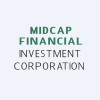
MFIC
MidCap Financial Investment Corporation
$12.23
0.03
(0.25%)
| Exchange: | |
| Market Cap: | 1.141B |
| Shares Outstanding: | 20.698M |
About The Company
| Sector: | Financial Services | |||||
| Industry: | Asset Management | |||||
| CEO: | Tanner Powell | |||||
| Full Time Employees: | ||||||
| Address: |
|
|||||
| Website: | https://www.apolloic.com |
Apollo Investment Corporation is business development company and a closed-end, externally managed, non-diversified management investment company. It is elected to be treated as a business development company (BDC) under the Investment Company Act of 1940 (the 1940 Act) specializing in private equity investments in leveraged buyouts, acquisitions, recapitalizations, growth capital, refinancing and private middle market companies. It provides direct equity capital, mezzanine, first lien secured loans, stretch senior loans, unitranche loans, second lien secured loans and senior secured loans, unsecured debt, and subordinated debt and loans. It also seeks to invest in PIPES transactions. The fund may also invest in securities of public companies that are thinly traded and may acquire investments in the secondary market and structured products. It prefers to invest in preferred equity, common equity / interests and warrants and makes equity co-investments. It may invest in cash equivalents, U.S. government securities, high-quality debt investments that mature in one year or less, high-yield bonds, distressed debt, non-U.S. investments, or securities of public companies that are not thinly traded. It also focuses on other investments such as collateralized loan obligations (CLOs) and credit-linked notes (CLNs). The fund typically invests in construction and building materials, business services, plastics & rubber, advertising, capital equipment, education, cable television, chemicals, consumer products/goods durable and non-durable and customer services, direct marketing, energy oil & gas, electricity and utilities. The fund also invest in aerospace & defense, wholesale, telecommunications, financial services, hotel, gaming, leisure, restaurants; environmental industries, healthcare and pharmaceuticals, high tech industries, beverages, food and tobacco, manufacturing, media diversified & production, printing and publishing, retail, automation, aviation and consumer transport, transportation, cargo and distribution. It primarily invests in United States. It primarily invests between $20 million and $250 million in its portfolio companies. The fund seeks to make investments with stated maturities of five to 10 years.
Click to read more…
Revenue Segmentation
EPS
Earnings Call
Income Statement
(* All numbers are in thousands)
Balance Sheet
(* All numbers are in thousands)
Cash Flow Statement
(* All numbers are in thousands)
Analyst Estimates
(* All numbers are in thousands)




